Stock Status of Noncommercial Fish Species in Aras Dam Reservoir: Mismanagement Endangers Sustainable Fisheries
Simple Summary
Abstract
1. Introduction
2. Materials and Methods
2.1. Study Area and Fishery Data
2.2. CMSY++ and BSM Methods
2.3. Biometric Data and Length–Weight Relationship
2.4. Statistical Analysis
3. Results
3.1. CMSY++ Model and BSM
3.2. Length–Weight Relationship
4. Discussion
5. Conclusions
Author Contributions
Funding
Institutional Review Board Statement
Informed Consent Statement
Data Availability Statement
Acknowledgments
Conflicts of Interest
References
- Food and Agriculture Organization. The State of World Fisheries and Aquaculture 2024: Blue Transformation in Action; Food and Agriculture Organization: Rome, Italy, 2024; Available online: https://policycommons.net/artifacts/12522071/the-state-of-world-fisheries-and-aquaculture-2024-blue-transformation-in-action/ (accessed on 16 August 2025).
- Froese, R.; Zeller, D.; Kleisner, K.; Pauly, D. What catch data can tell us about the status of global fisheries. Mar. Biol. 2012, 159, 1283–1292. [Google Scholar] [CrossRef]
- Froese, R.; Demirel, N.; Coro, G.; Kleisner, K.M.; Winker, H. Estimating fisheries reference points from catch and resilience. Fish Fish. 2017, 18, 506–526. [Google Scholar] [CrossRef]
- Martell, S.; Froese, R. A simple method for estimating MSY from catch and resilience. Fish Fish. 2013, 14, 504–514. [Google Scholar] [CrossRef]
- Froese, R.; Winker, H.; Coro, G.; Demirel, N.; Tsikliras, A.C.; Dimarchopoulou, D.; Scarcella, G.; Quaas, M.; Matz-Lück, N. Status and rebuilding of European fisheries. Mar. Policy 2018, 93, 159–170. [Google Scholar] [CrossRef]
- Palomares, M.L.D.; Froese, R.; Derrick, B.; Nöel, S.-L.; Tsui, G.; Woroniak, J.; Pauly, D. A Preliminary Global Assessment of the Status of Exploited Marine Fish and Invertebrate Populations; Sea Around Us: Vancouver, BC, Canada, 2018; p. 64. Available online: https://oceanrep.geomar.de/id/eprint/43547/1/OceanaReportFinal.pdf (accessed on 24 August 2025).
- Ju, P.; Tian, Y.; Chen, M.; Yang, S.; Liu, Y.; Xing, Q.; Sun, P. Evaluating stock status of 16 commercial fish species in the coastal and offshore waters of Taiwan using the CMSY and BSM methods. Front. Mar. Sci. 2020, 7, 618. [Google Scholar] [CrossRef]
- Andrašūnas, V.; Ivanauskas, E.; Švagždys, A.; Razinkovas-Baziukas, A. Assessment of four major fish species stocks in the Lithuanian and Russian parts of Curonian Lagoon (SE Baltic Sea) using CMSY method. Fishes 2022, 7, 9. [Google Scholar] [CrossRef]
- Sarr, O.; Kindong, R.; Sow, F.N.; Tian, S. Estimation of Atlantic bonito (Sarda sarda) stock status in the Senegalese Exclusive Economic Zone (SEEZ) from the catch-based model (CMSY) and length-based Bayesian estimation (LBB) method. Reg. Stud. Mar. Sci. 2023, 65, 103052. [Google Scholar] [CrossRef]
- Chen, L.; Ju, P.; Lu, Z.; Liang, C.; Chen, B.; Du, J.; Li, P. Assessments of 12 commercial species stocks in a subtropical upwelling ecosystem using the CMSY and BSM methods. Fishes 2024, 9, 332. [Google Scholar] [CrossRef]
- Edgar, G.J.; Bates, A.E.; Krueck, N.C.; Baker, S.C.; Stuart-Smith, R.D.; Brown, C.J. Stock assessment models overstate sustainability of the world’s fisheries. Science 2024, 384, 860–865. [Google Scholar] [CrossRef] [PubMed]
- Froese, R.; Pauly, D. Taking stock of global fisheries. Science 2024, 384, 824–825. [Google Scholar] [CrossRef]
- Hajihoseini, M.; Morid, S.; Emamgholizadeh, S.; Amirahmadian, B.; Mahjoobi, E.; Gholami, H. Conflict and cooperation in Aras International Rivers Basin: Status, trend, and future. Sustain. Water Resour. Manag. 2023, 9, 28. [Google Scholar] [CrossRef]
- Mirzaei, M.; Jafari, A.; Verriest, J.; Haghighi, M.; Zargarnia, A.H.; Khoshnoodmotlagh, S.; Azadi, H.; Scheffran, J. Trans-boundary land cover changes and its influences on water crisis: Case study of the Aras River. Appl. Geogr. 2020, 124, 102323. [Google Scholar] [CrossRef]
- Mohebbi, F. Aras River Dam Reservoir pollutions: Human activities or climate change? Ecol. Water Resour. 2021, 5, 60–66. [Google Scholar]
- Abbasi, K.; Sarpanah, A. Fish fauna investigation in Arass Reservoir and its Iranian tributaries. Iran. Sci. Fish. J. 2001, 10, 41–62. [Google Scholar]
- Çelekli, A.; Kayhan, S.; Lekesiz, Ö.; Toudjani, A.A.; Çetin, T. Limno-ecological assessment of Aras River surface waters in Turkey: Application of diatom indices. Environ. Sci. Pollut. Res. 2019, 26, 8028–8038. [Google Scholar] [CrossRef] [PubMed]
- Schaefer, M.B. Some aspects of the dynamics of populations important to the management of the commercial marine fisheries. Bull. Math. Biol. 1991, 53, 253–279. [Google Scholar] [CrossRef]
- Kimura, D.K.; Tagart, J.V. Stock reduction analysis, another solution to the catch equations. Can. J. Fish. Aquat. Sci. 1982, 39, 1467–1472. [Google Scholar] [CrossRef]
- Walters, C.J.; Martell, S.J.; Korman, J. A stochastic approach to stock reduction analysis. Can. J. Fish. Aquat. Sci. 2006, 63, 212–223. [Google Scholar] [CrossRef]
- Froese, R.; Winker, H.; Coro, G.; Palomares, M.-L.; Tsikliras, A.C.; Dimarchopoulou, D.; Touloumis, K.; Demirel, N.; Vianna, G.; Scarcella, G. New developments in the analysis of catch time series as the basis for fish stock assessments: The CMSY++ method. Acta Ichthyol. Piscat. 2023, 53, 173–189. [Google Scholar] [CrossRef]
- Pauly, D. Fish Population Dynamics in Tropical Waters: A manual for Use with Programmable Calculators. ICLARM Studies and Reviews; WorldFish: Penang, Malaysia, 1984; Volume 8, 325p. [Google Scholar]
- Millar, R.; Meyer, R. Nonlinear State-Space Modeling of Fisheries Biomass Dynamics Using the Gibbs Sampler; Technical Report 98/2; Department of Statistics, University of Auckland: Auckland, New Zealand, 1998. [Google Scholar]
- Thorson, J.T.; Ono, K.; Munch, S.B. A Bayesian approach to identifying and compensating for model misspecification in population models. Ecology 2014, 95, 329–341. [Google Scholar] [CrossRef] [PubMed]
- Barman, P.; Karim, E.; Khatun, M.; Rahman, M.; Alam, M.; Liu, Q. Application of CMSY to estimate biological reference points of Bombay duck (Harpadon neherus) from the Bay of Bengal, Bangladesh. Appl. Ecol. Environ. Res. 2020, 18, 8023–8034. [Google Scholar] [CrossRef]
- Kalhoro, M.A.; Liu, Q.; Zhu, L.; Jiang, Z.; Liang, Z. Assessing fishing capacity of two tuna fish species using different time-series data in Pakistan, Northern Arabian Sea. Estuar. Coast. Shelf Sci. 2024, 299, 108692. [Google Scholar] [CrossRef]
- Ji, Y.; Liu, Q.; Liao, B.; Zhang, Q.; Han, Y.N. Estimating biological reference points for Largehead hairtail (Trichiurus lepturus) fishery in the Yellow Sea and Bohai Sea. Acta Oceanol. Sin. 2019, 38, 20–26. [Google Scholar] [CrossRef]
- Wang, Y.; Wang, Y.; Liang, C.; Zhang, H.; Xian, W. Assessment of 12 fish species in the northwest Pacific using the CMSY and BSM methods. Front. Mar. Sci. 2020, 7, 616. [Google Scholar] [CrossRef]
- Ren, Q.-Q.; Liu, M. Assessing northwest Pacific fishery stocks using two new methods: The Monte Carlo catch-MSY (CMSY) and the Bayesian Schaefer model (BSM). Front. Mar. Sci. 2020, 7, 430. [Google Scholar] [CrossRef]
- Chen, C.-S. Management of the precious coral fishery in Taiwan: Progress and perspectives. Mar. Policy 2012, 36, 623–629. [Google Scholar] [CrossRef]
- Huang, H.-W.; Chuang, C.-T. Fishing capacity management in Taiwan: Experiences and prospects. Mar. Policy 2010, 34, 70–76. [Google Scholar] [CrossRef]
- Kanamori, Y.; Takasuka, A.; Nishijima, S.; Okamura, H. Climate change shifts the spawning ground northward and extends the spawning period of chub mackerel in the western North Pacific. Mar. Ecol. Prog. Ser. 2019, 624, 155–166. [Google Scholar] [CrossRef]
- Yatsu, A. Review of population dynamics and management of small pelagic fishes around the Japanese Archipelago. Fish. Sci. 2019, 85, 611–639. [Google Scholar] [CrossRef]
- Saraux, C.; Van Beveren, E.; Brosset, P.; Queiros, Q.; Bourdeix, J.-H.; Dutto, G.; Gasset, E.; Jac, C.; Bonhommeau, S.; Fromentin, J.-M. Small pelagic fish dynamics: A review of mechanisms in the Gulf of Lions. Deep.-Sea Res. Part II Top. Stud. Oceanogr. 2019, 159, 52–61. [Google Scholar] [CrossRef]
- Hilborn, R.; Amoroso, R.O.; Anderson, C.M.; Baum, J.K.; Branch, T.A.; Costello, C.; De Moor, C.L.; Faraj, A.; Hively, D.; Jensen, O.P. Effective fisheries management instrumental in improving fish stock status. Proc. Natl. Acad. Sci. USA 2020, 117, 2218–2224. [Google Scholar] [CrossRef] [PubMed]
- Zimmermann, F.; Werner, K.M. Improved management is the main driver behind recovery of Northeast Atlantic fish stocks. Front. Ecol. Environ. 2019, 17, 93–99. [Google Scholar] [CrossRef]
- Zhai, L.; Liang, C.; Pauly, D. Assessments of 16 exploited fish stocks in Chinese waters using the CMSY and BSM methods. Front. Mar. Sci. 2020, 7, 483993. [Google Scholar] [CrossRef]
- Muto, E.Y.; Soares, L.S.H.; Wongtschowski, C.L.D.B.R. Length–weight relationship of marine fish species off São Sebastião system, São Paulo, southeastern Brazil. NAGA ICLARM Q. 2000, 23, 27–29. [Google Scholar]
- Kohler, N.E.; Casey, J.G.; Turner, P.A. Length–weight relationships for 13 species of sharks from the western North Atlantic. Fish. Bull. 1995, 93, 412–418. [Google Scholar]
- Martin-Smith, K.M. Length/weight relationships of fishes in a diverse tropical freshwater community, Sabah, Malaysia. J. Fish Biol. 1996, 49, 731–734. [Google Scholar] [CrossRef]
- Safran, P. Theoretical analysis of the weight–length relationship in fish juveniles. Mar. Biol. 1992, 112, 545–551. [Google Scholar] [CrossRef]
- Morato, T.; Afonso, P.; Lourinho, P.; Barreiros, J.P.; Santos, R.S.; Nash, R. Length–weight relationships for 21 coastal fish species of the Azores, north-eastern Atlantic. Fish. Res. 2001, 50, 297–302. [Google Scholar] [CrossRef]
- Deekae, S.N.; Abowei, J.F.N. Macrobrachium macrobrachion (Herklots, 1851) length–weight relationship and Fulton’s condition factor in Luubara Creek, Ogoni land, Niger Delta, Nigeria. Int. J. Anim. Vet. Adv. 2010, 2, 155–162. [Google Scholar]
- Kuriakose, S. Estimation of length–weight relationship in fishes. In Course Manual Summer School on Advanced Methods for Fish Stock Assessment and Fisheries Management; Lecture Note Series No. 2/2017; CMFRI: Kochi, India, 2017; pp. 215–220. [Google Scholar]
- Bagenal, T.B.; Tesch, F.W. Age and Growth. In Methods for Assessment of Fish Production in Freshwaters, 3rd ed.; Bagenal, T.B., Ed.; IBP Handbook No. 3; Blackwell Scientific Publications: Oxford, UK, 1978; pp. 101–136. [Google Scholar]
- Yılmaz, S.; Yazıcıoğlu, O.; Erbaşaran, M.; Esen, S.; Zengin, M.; Polat, N. Length–weight relationship and relative condition factor of white bream, Blicca bjoerkna (L., 1758), from Lake Ladik, Turkey. J. Black Sea/Mediterr. Environ. 2012, 18, 380–387. [Google Scholar]
- Papageorgiou, N. The length–weight relationship, age, growth and reproduction of the roach Rutilus rutilus (L.) in Lake Volvi. J. Fish Biol. 1979, 14, 529–538. [Google Scholar] [CrossRef]
- Verreycken, H.; Van Thuyne, G.; Belpaire, C. Length–weight relationships of 40 freshwater fish species from two decades of monitoring in Flanders (Belgium). J. Appl. Ichthyol. 2011, 27, 1416–1421. [Google Scholar] [CrossRef]
- Froese, R. Cube law, condition factor and weight–length relationships: History, meta-analysis and recommendations. J. Appl. Ichthyol. 2006, 22, 241–253. [Google Scholar] [CrossRef]
- Moutopoulos, D.; Stergiou, K. Length–weight and length–length relationships of fish species from the Aegean Sea (Greece). J. Appl. Ichthyol. 2002, 18, 200–203. [Google Scholar] [CrossRef]
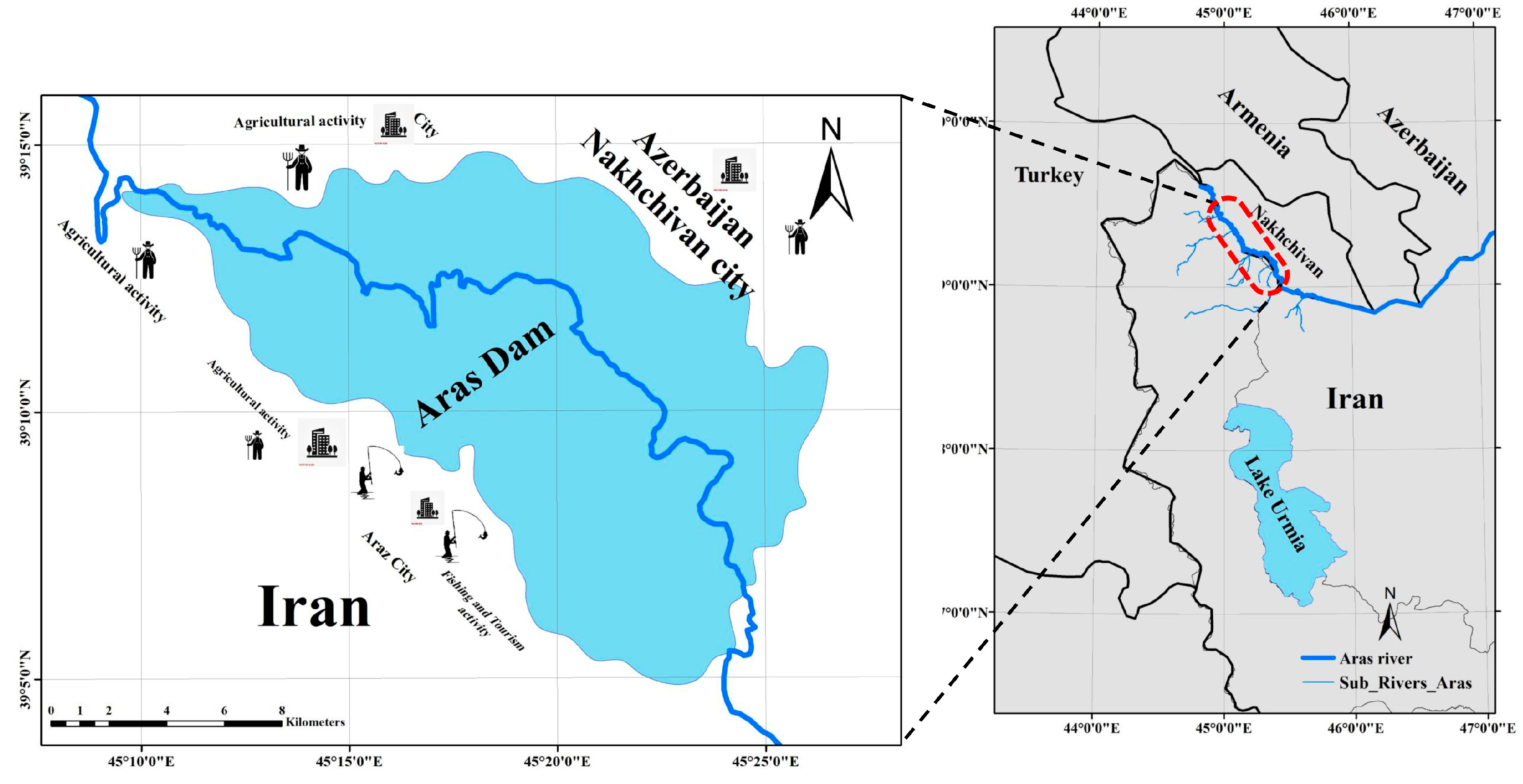


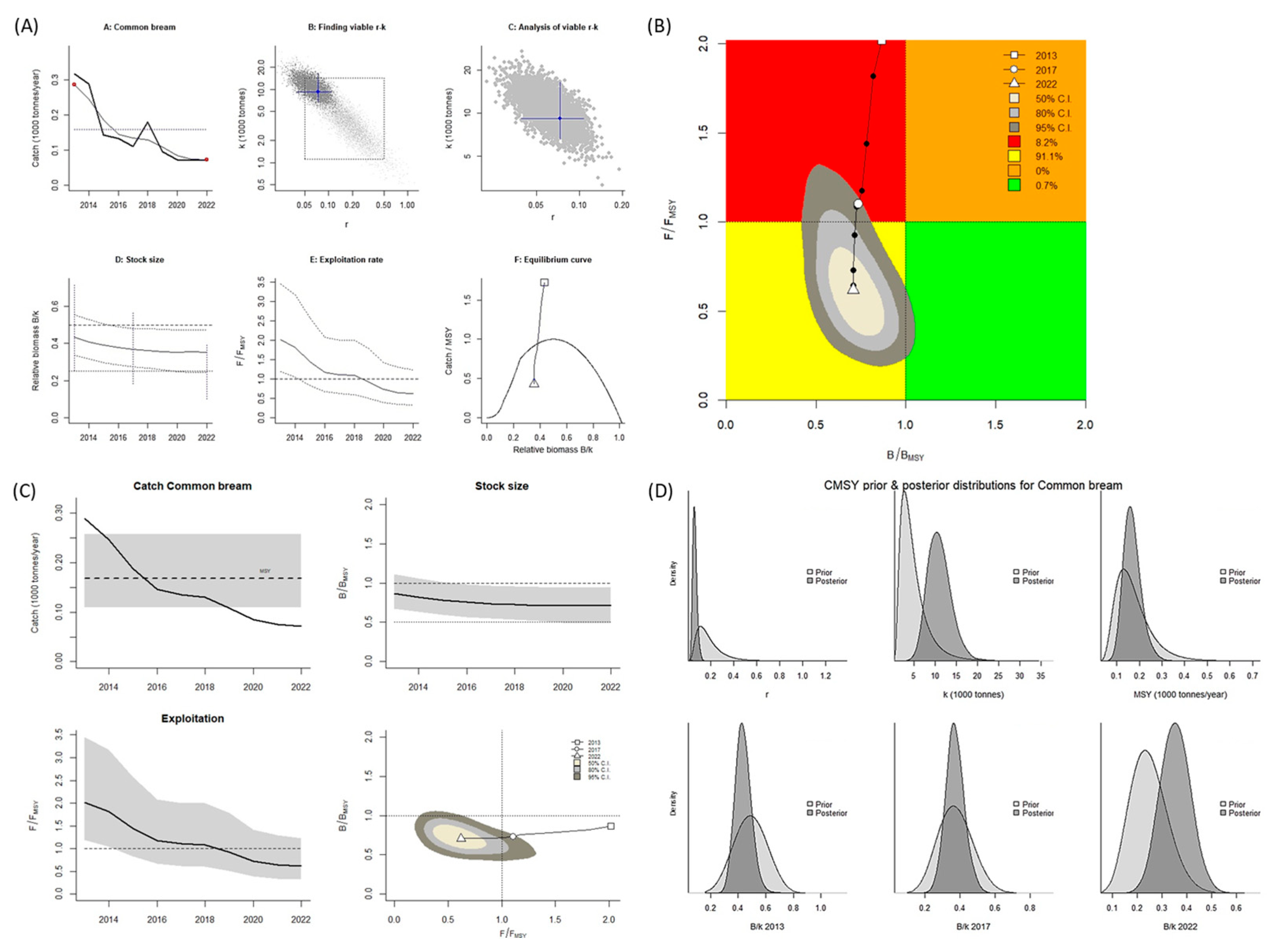
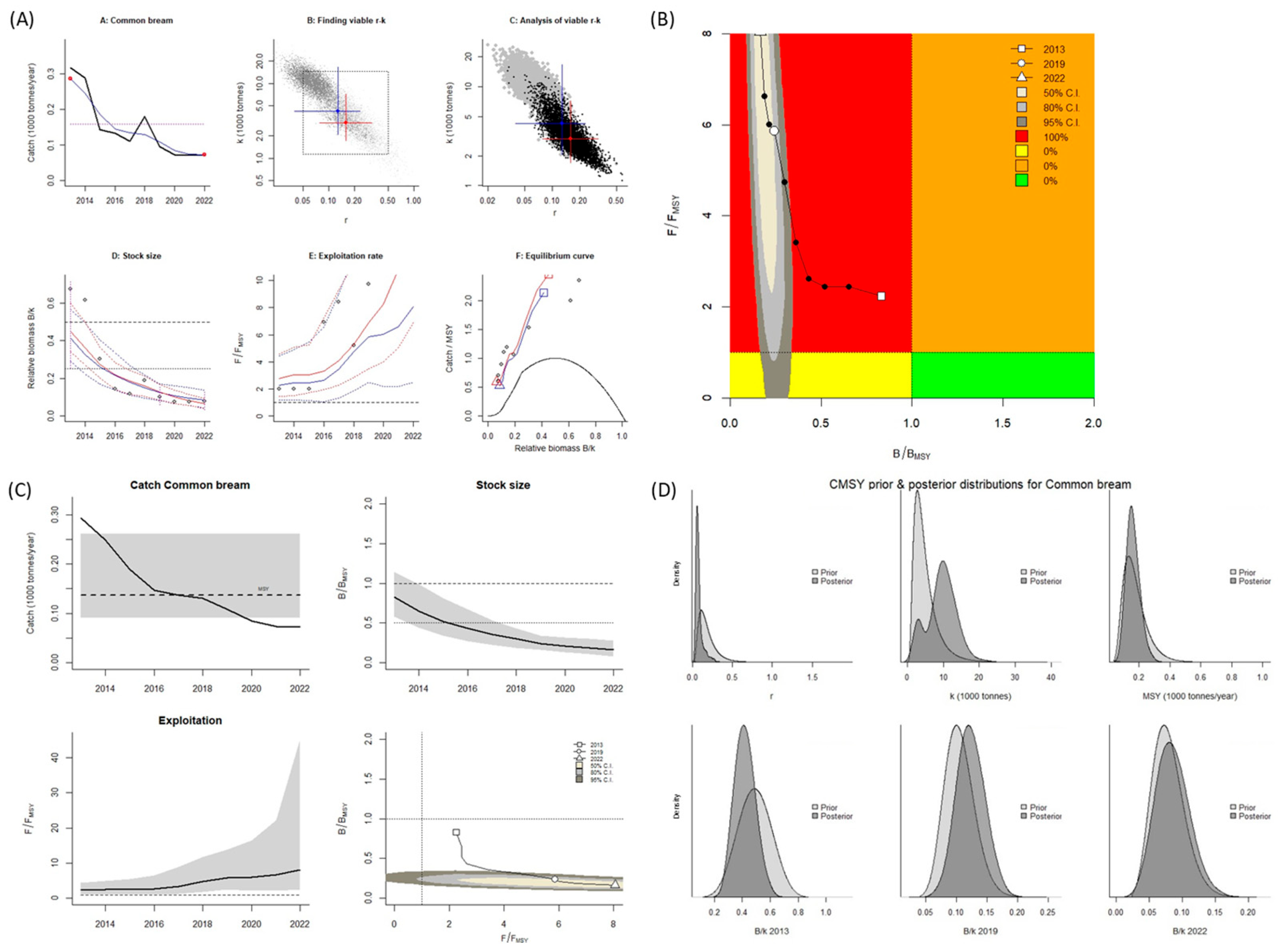


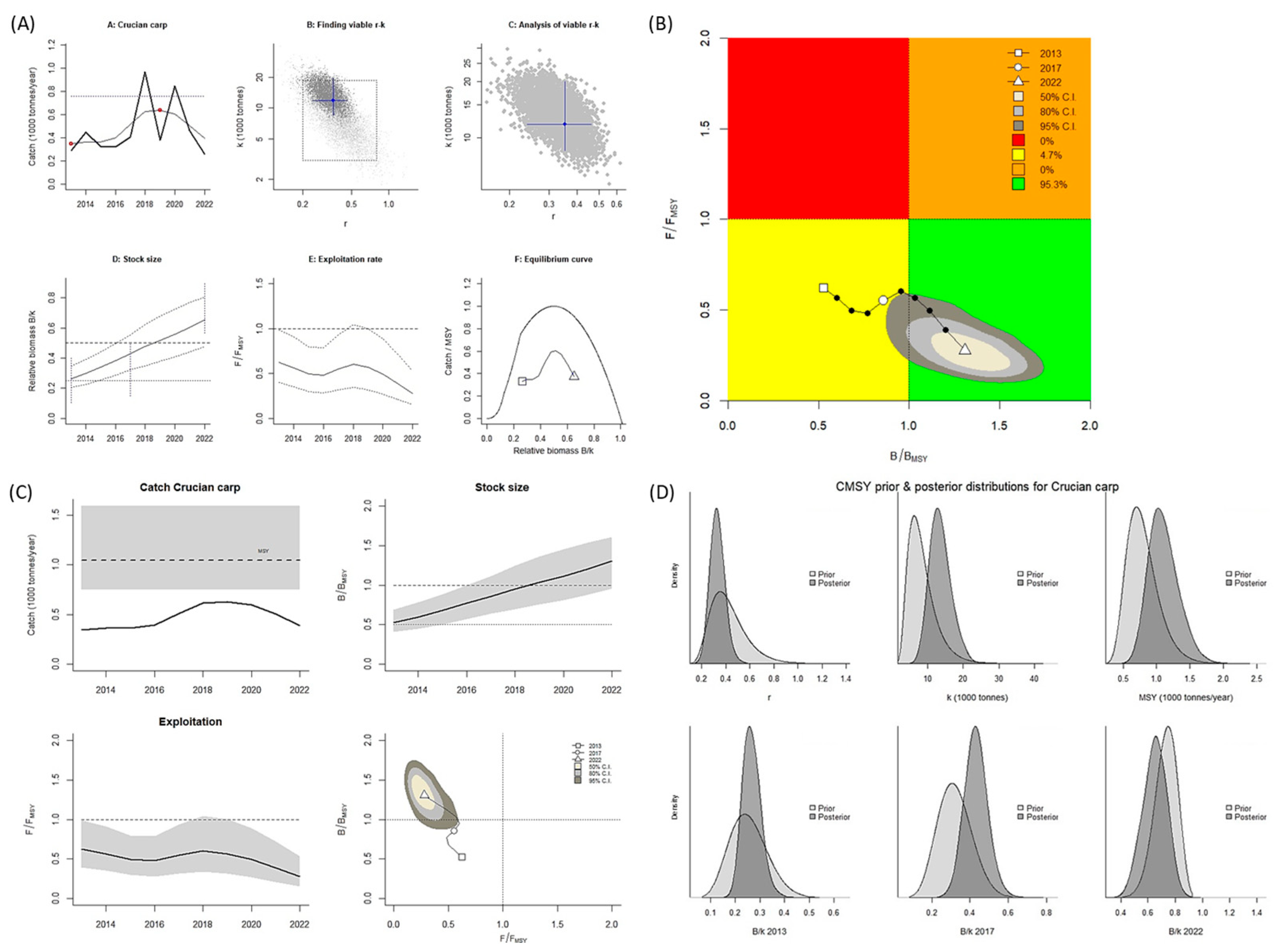
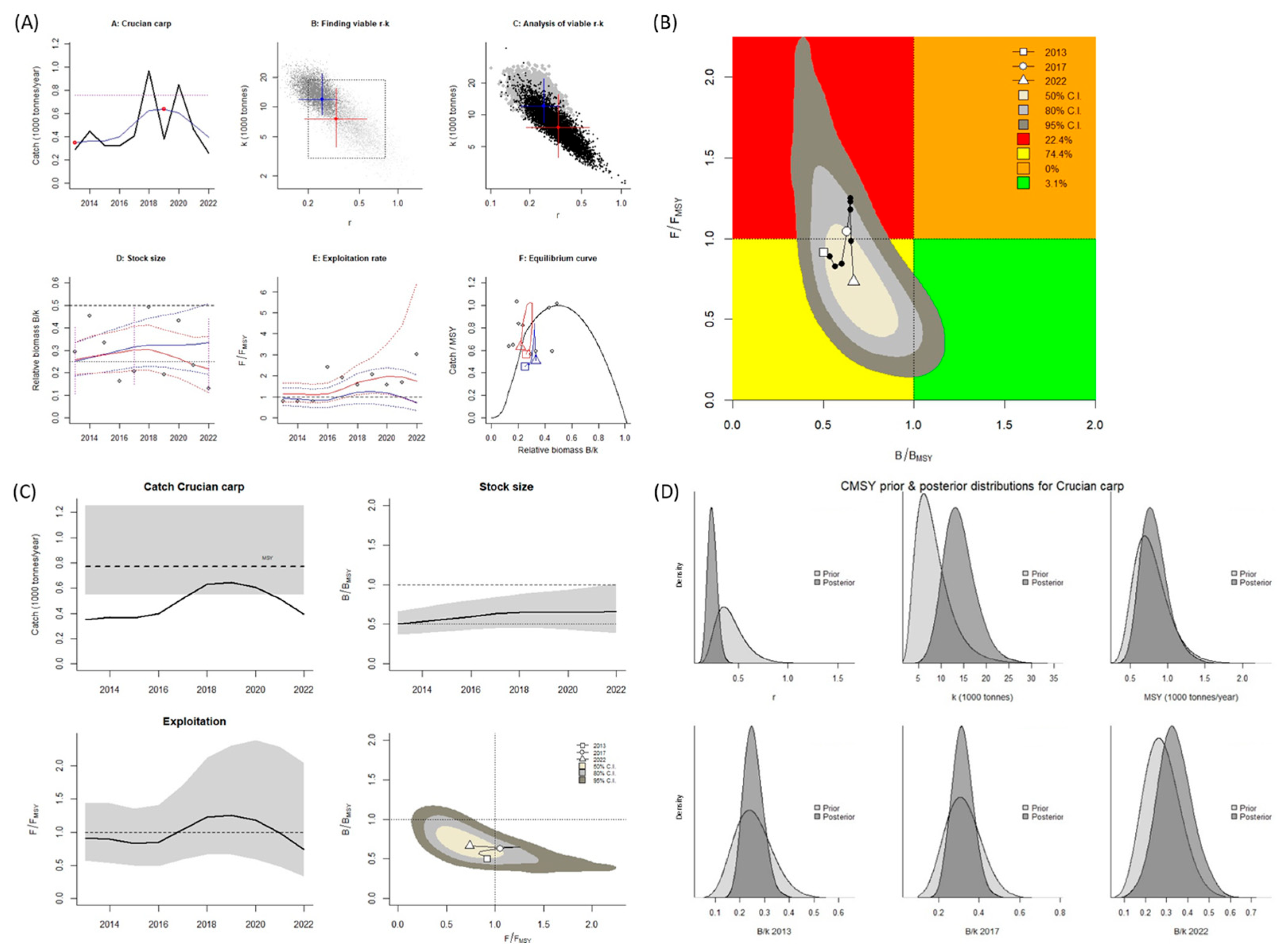
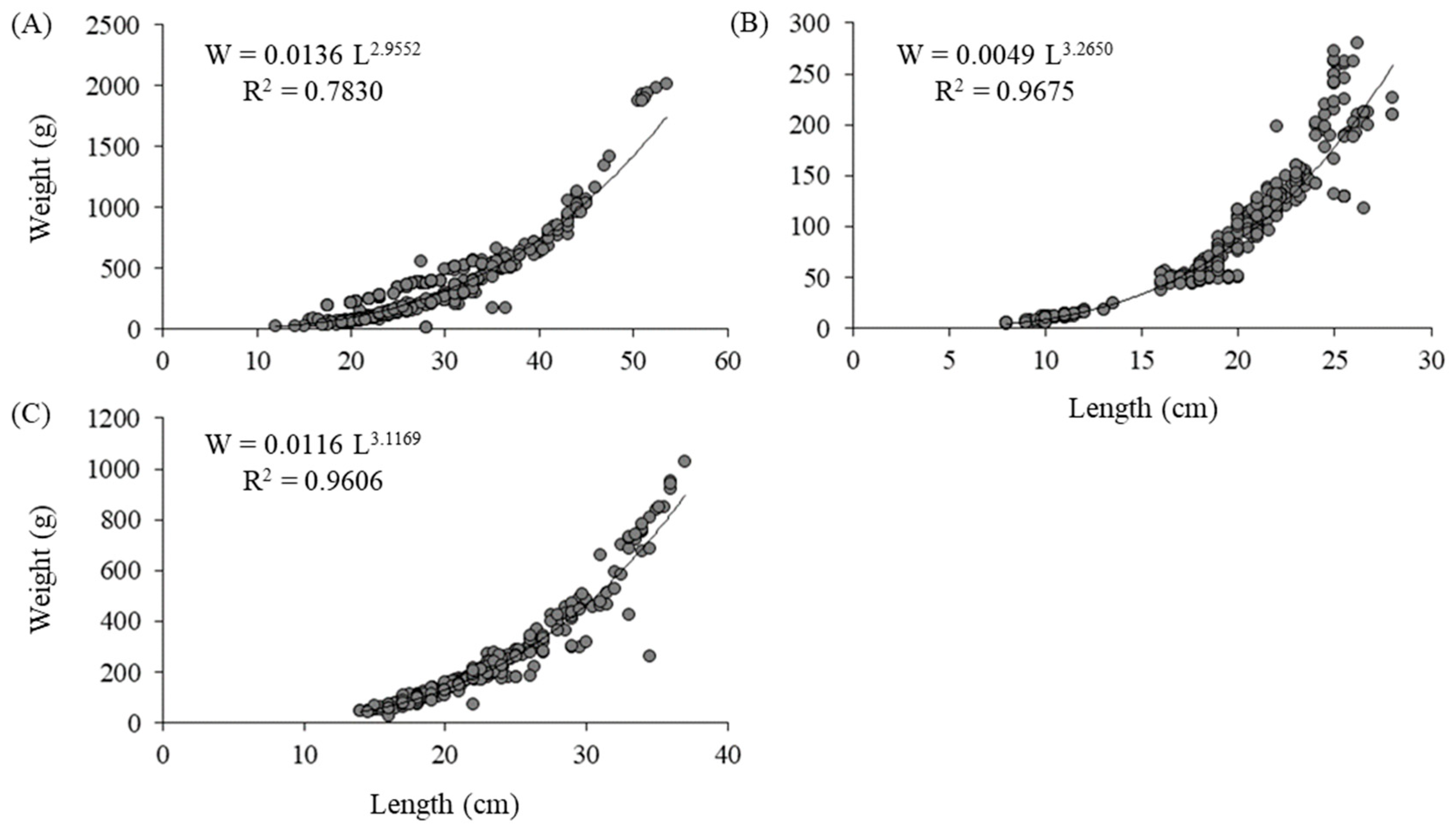
| Parameter | Estimated Values | |
|---|---|---|
| CMSY++ | BSM | |
| Biomass (B) | 5.98 (3.59–9.63) | 5.91 (3.45–9.38) |
| MSY | 0.769 (0.537–1.21) | 0.75 (0.537–1.19) |
| BMSY | 4.82 (3.47–7.96) | 4.73 (3.46–7.96) |
| FMSY | 0.16 (0.11–0.209) | 0.159 (0.11–0.207) |
| B/BMSY | 1.12 (0.795–1.44) | 1.11 (0.772–1.44) |
| Exploitation F/FMSY | 0.557 (0.294–1.07) | 0.556 (0.301–1.1) |
| Fishing mortality (F) | 0.0821 (0.0464–0.146) | 0.0825 (0.0474–0.153) |
| Relative biomass in last year | 0.559 k (0.397–0.718) | 0.553 k (0.386–0.72) |
| K | 9.64 (6.93–15.9) | 9.46 (6.91–15.9) |
| R | 0.319 (0.22–0.418) | 0.317 (0.219–0.414) |
| BMSY/K | 0.62 | 0.62 |
| Depletion level | Low | Low |
| Trophic level | 3.2 | |
| Parameter | Estimated Values | |
|---|---|---|
| CMSY++ | BSM | |
| Biomass (B) | 3.76 (2.05–6.38) | 0.817 (0.109–1.89) |
| MSY | 0.168 (0.109–0.258) | 0.137 (0.0906–0.261) |
| B MSY | 4.59 (3.28–8.26) | 2.13 (1.03–8.33) |
| F MSY | 0.0365 (0.0196–0.0534) | 0.0644 (0.02–0.116) |
| B/BMSY | 0.708 (0.498–0.945) | 0.167 (0.083–0.277) |
| Exploitation F/FMSY | 0.62 (0.325–1.23) | 8.05 (2.48–45.2) |
| Fishing mortality (F) | 0.0197 (0.104–0.0373) | 0.0887 (0.0367–0.671) |
| Relative biomass in last year | 0.354 k (0.244–0.473) | 0.0836 k (0.0415–0.139) |
| K | 9.17 (6.55–16.5) | 4.25 (2.07–16.7) |
| r | 0.0731 (0.0392–0.107) | 0.129 (0.0399–0.232) |
| BMSY/K | 0.41 | 0.19 |
| Depletion level | Medium | Very Strong |
| Trophic level | 3.1 | |
Disclaimer/Publisher’s Note: The statements, opinions and data contained in all publications are solely those of the individual author(s) and contributor(s) and not of MDPI and/or the editor(s). MDPI and/or the editor(s) disclaim responsibility for any injury to people or property resulting from any ideas, methods, instructions or products referred to in the content. |
© 2025 by the authors. Licensee MDPI, Basel, Switzerland. This article is an open access article distributed under the terms and conditions of the Creative Commons Attribution (CC BY) license (https://creativecommons.org/licenses/by/4.0/).
Share and Cite
Haghi Vayghan, A.; Ghanbarzadeh, M.; Su, N.-J. Stock Status of Noncommercial Fish Species in Aras Dam Reservoir: Mismanagement Endangers Sustainable Fisheries. Biology 2025, 14, 1242. https://doi.org/10.3390/biology14091242
Haghi Vayghan A, Ghanbarzadeh M, Su N-J. Stock Status of Noncommercial Fish Species in Aras Dam Reservoir: Mismanagement Endangers Sustainable Fisheries. Biology. 2025; 14(9):1242. https://doi.org/10.3390/biology14091242
Chicago/Turabian StyleHaghi Vayghan, Ali, Mehrnaz Ghanbarzadeh, and Nan-Jay Su. 2025. "Stock Status of Noncommercial Fish Species in Aras Dam Reservoir: Mismanagement Endangers Sustainable Fisheries" Biology 14, no. 9: 1242. https://doi.org/10.3390/biology14091242
APA StyleHaghi Vayghan, A., Ghanbarzadeh, M., & Su, N.-J. (2025). Stock Status of Noncommercial Fish Species in Aras Dam Reservoir: Mismanagement Endangers Sustainable Fisheries. Biology, 14(9), 1242. https://doi.org/10.3390/biology14091242







